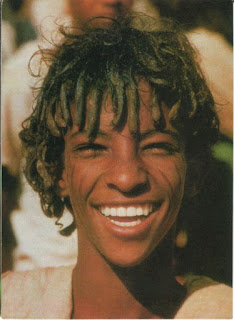Eritrea culture food people and festivals
The culture of Eritrea is the collective cultural heritage of the various populations inhabiting Eritrea. It shares historic commonalities with the traditions of Ethiopia, Somalia, Djibouti and Sudan.[1] Additionally, the culture of Eritrea has some ties with those of the Near East. The local culture consists of various, and often quite similar, traditions practiced by the nation's many Cushitic and Semitic-speaking Afro-Asiatic ethnic groups, in addition to those practiced by the area's Nilotic minorities. Eritrea's semi-arid terrain in the northeastern Sahel and its unique climate have also been important influences on local customs.
\
Food in Daily Life.Eritrean cuisine is a reflection of the country's history. Theinjerrais commonly eaten in the rural areas. It is a pancake-like bread that is eaten together with a sauce calledtsebhiorwat. The sauce may be of a hot and spicy meat variety, or vegetable based. In the urban centers one finds the strong influence of Italian cuisine, and pasta is served in all restaurants. The lowland groups have a different food tradition than the highlands with the staple food being a porridge (asidain Arabic) made of sorghum.
Food Customs at Ceremonial Occasions.Both Islam and theOrthodox Christiantradition require rigorous observance of fasts and food taboos. Several periods of fasting, the longest being Lent among the Orthodox and Ramadan among Muslims, have to be adhered to by all adults. During religious celebrations, however, food and beverages are served in plenty. Usually an ox, sheep, or goat is slaughtered. The meat and the intestines are served together with the injerra. Traditional beer (siwa)is brewed in the villages and is always served during ceremonial occasions
Social Stratification
Classes and Castes.Eritrean society is divided along ethnic, religious, and social lines. Traditionally, there were low caste groups within many of the ethnic groups in the country. The last slave was reportedly emancipated by the EPLF in the late 1970s. The traditional elites were the landowning families. After land reforms both during and after the liberation struggle, however, these elites have ceased to exist. Generally, in the rural areas, the people live in scarcity and poverty and few distinctions between rich and poor are seen. In the urban areas, however, a modern elite is emerging, composed of high-ranking civil servants, business-people, and Eritreans returning from the diaspora in the United States and Europe
he Eritrean-Ethiopian region has been exposed to population movements and migrations from northern Africa, across the Red Sea, and from the south. On the border between Eritrea and Ethiopia, one also finds traces of some of Africa's oldest civilizations. TheAxumiteempire, which emerges into the light of history in the first centuryC.E., comprised the Akkele-Guzai region of highland Eritrea and the Agame region of Tigray, Ethiopia. The empire expanded and its port city of Adulis, south of present-day Massawa, became an important trading post hosting ships from Egypt, Greece, the Arab world, and other far-off areas. In the early fourth century Enzana, the king of Axum, converted to Christianity. He thus established Christianity as the religion of the court and state, making the Ethiopian/Eritrean Christian Church one of the oldest in the world. The decline of the Axumite empire began around 800, when its area of dominance became too big to administer efficiently. Moreover, local resistance and uprisings coupled with the domination of overseas trade by the Islamic empire in the Middle East led to the collapse of the kingdom. Ethiopia was subsequently constructed on the legacy of Axum.
Marriage, Family, and Kinship
Marriage.Customary rules of marriage vary among the ethnic groups. Generally, girls marry at an early age, sometimes as young as fourteen. A large share of the marriages in the rural areas are still arranged by the family groups of concern.
Domestic Unit.Generally, people live together in nuclear families, although in some ethnic groups the family structure is extended. The man is the public decision-maker in the family, whereas the woman is responsible for organizing the domestic activities of the household.
Inheritance.Inheritance rules in Eritrea follow the customary norms of the different ethnic groups. Generally, men are favored over women, and sons inherit their parents' household possessions.
Kin Groups.The nuclear family, although forming the smallest kin unit, is always socially embedded in a wider kin unit. The lineage and/or clan hold an organizing function in terms of social duties and obligations and as a level of identity. With the exception of the Kunama who are matrilineal, all ethnic groups in Eritrea are patrilineal, that is, descent is traced through the male line
Eritrea has nine ethnic groups, each of which have their own different styles of music and accompanying dances. A common instrument used by many of the communities is the drum. Amongst the Tigray-Tigrinya, the best known traditional musical genre is called guaila.
























No comments:
Post a Comment